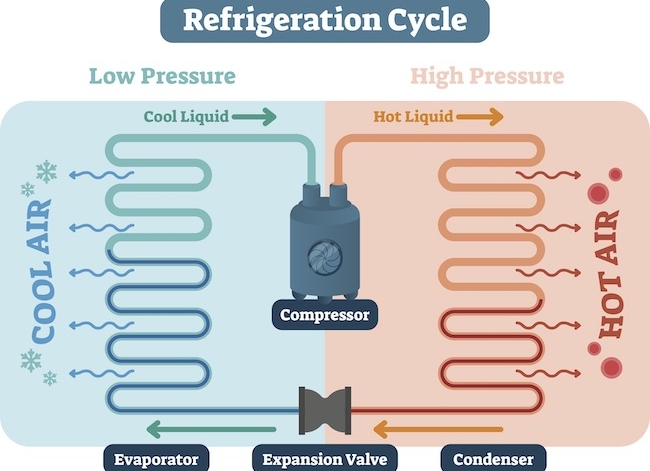
With global warming and strained electrical grids, optimized performance is more important than ever in air conditioning. Measuring instruments help HVAC/R systems operate more efficiently and sustainably.
Modern air conditioning has fundamentally improved the way we work and live. At the same time, HVAC/R consumes the most energy in homes, offices, and businesses. To help protect the planet without sacrificing health or comfort, refrigeration and air handling systems need reliable measuring instruments to monitor pressure, temperature, and airflow.
Principles Behind the Vapor-Compression Refrigeration Cycle
To cool indoor air, most air conditioners use the vapor-compression refrigeration cycle. This method utilizes the phase change in refrigerants – from gas (high pressure/high temperature) to liquid (low pressure/low temperature) and back again – in order to capture heat and transfer it from where it is unwanted.

Vapor-compression refrigeration cycle
The main components in refrigeration are a compressor, condenser coil, expansion valve, and evaporator coil. To ensure proper operations and minimize problems, it is prudent to monitor conditions at different points. A pressure transmitter, like the R-1, on the hermetically sealed suction line going to the compressor can help ensure that there is no liquid refrigerant returning to the compressor, which would damage it. Pressure transmitters on the discharge line can let system operators see the capacity being produced. The relationship between pressure and temperature make pressure measurement invaluable in many HVAC/R systems.
The measurement most commonly associated with HVAC/R is probably temperature, as thermostats or controllers will send signals calling for cooling or heating based on room temperatures. The third area to measure for optimal system operation is air flow and velocity.
Requirements of HVAC Systems
Heating and cooling are important, but those are not the only requirements placed on today’s HVAC systems. With global warming and strained electrical grids, energy efficiency is more important than ever.
- Performance metrics – The HVAC industry has several ratings to indicate performance, such as SEER (Seasonal Energy Efficient Ratio), COP (Coefficient of Performance), AFUE (Annual Fuel Utilization Efficiency), HSPF (Heating Seasonal Performance Factor), and so on. For all metrics, a higher number indicates greater efficiency.
- Mandated efficiency standards – Starting in 2023, new efficiency standards will go into effect in the US. All new residential air conditioners must be at least 14 SEER (15 SEER in the Southeast and Southwest). For heat pumps, the minimum will be 8.8 HSPF. Commercial packaged RTUs also have new equipment efficiency standards that go into effect the same year.
- Refrigerant phase-outs – Older refrigerants were fluorocarbons that, while efficient, thinned the ozone layer or contributed to global warming. Many have been phased out already. In the US, the last step to completing the Montreal Protocol Phaseout Schedule is to ban the production or import of any hydrochlorofluorocarbons (HCFCs) by 2030. The aim is to encourage natural refrigerants such as air, water, carbon dioxide, ammonia, and hydrocarbons (propane, isobutane, etc.).
All these requirements help improve the planet’s health, but they do add another layer of complexity to the design and operation of HVAC systems.
In addition to efficiency, users have other demands of HVAC systems and air handling units:
- Comfortable humidity levels – Air that’s too dry can lead to skin problems, respiratory issues, and wood damage. Research also shows that COVID-19 spread more easily in low humidity. But if air is too humid, the building’s occupants feel sticky and uncomfortable; mold begins to grow, and certain viruses and bacteria proliferate.
- Good air quality – With most Americans spending significant time inside buildings, indoor air pollution is a major problem. A good HVAC system improves the quality of indoor air by removing fine particulates, dust mites, dander, mold, odors, and more hazardous pollutants like VOCs (volatile organic compounds).
- Proper ventilation – In January 2021, ASHRAE (American Society of Heating, Refrigerating, and Air-Conditioning Engineers) issued recommendations for reducing exposure to infectious aerosols to combat COVID-19. The guidelines regarded air exchange, recirculation, filtration, and clean air supplies for a room’s occupancy.
WIKA’s Role in a Healthier and More Efficient HVAC System
High-quality measuring instruments are the key to healthier, more comfortable indoor air. They also ensure that HVAC systems are operating efficiently and at their peak. WIKA’s air2guide™ series offers a full range of solutions expressly for HVAC applications. Other products in WIKA’s portfolio also contribute to safer refrigeration.
- Differential pressure gauges and transmitters to monitor filters, blowers, ventilators, and clean rooms
- Refrigeration gauges to measure refrigerants, including next-generation refrigerants
- Airflow transmitters in fans and ventilation ducts to ensure proper distribution
- RTDs and bimetal thermometers to measure the temperature of gaseous or liquid media
- Averaging RTDs to measure temperature along a duct or across a sectional area
- Frost detector thermostats to prevent frost damage in air heaters and heat exchangers
- Duct sensors to measure relative humidity and temperature
- Air quality sensor to detect VOCs as well as tobacco smoke, food smells, and body odor
- CO2 sensor to detect whether air quality drops in a crowded room
WIKA instruments are easy to mount or retrofit – regardless of the HVAC technology – and are worry- and maintenance-free. They come in analog versions as well as with digital interfaces for remote monitoring. What’s more, our HVAC experts understand industry guidelines, best practices, and compliance issues, and will work closely with you to select the best products for your applications.
Whether you’re planning a traditional or alternative HVAC system or are an OEM company, make WIKA USA part of your business.

